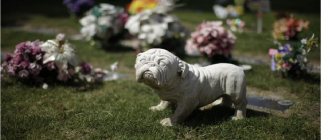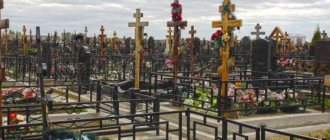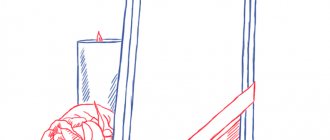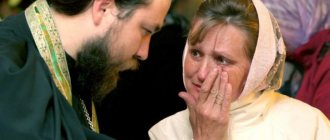Clothes: funeral dress
It is traditional to bury women in a dress. Some priests may no longer approve of an outfit with a blouse and skirt. What can we say about trousers: burying women in this comfortable modern clothing is considered shameful.
Requirements for funeral attire for women in the Orthodox faith:
- The length of the hem of a skirt or dress should not be above the knee.
- Deep cuts at the hem are not allowed.
- There should be no neckline on a blouse or dress.
- Bright colors, inscriptions and prints are not allowed.
- The attitude towards lace is ambiguous: some priests allow it, while others do not.
- Any clothing chosen must be new, ironed and neat.
- All elements of the outfit must be expressed in a single color scheme.
It is customary for women to be buried in light-colored clothing. But pure white color is allowed only for the attire of young girls. An elderly woman can be buried in dark clothes. Red color is considered unlucky according to popular beliefs and should not be used. The sign says that the deceased in red will take another family member with him to the next world. However, the Orthodox Church does not approve of such superstitions.
Funeral of men: how representatives of the stronger sex are buried according to Orthodox and secular custom
If the deceased man did not serve, then his body can be dressed in a white shirt, jacket, trousers, etc. If the deceased was a Christian, then it is not recommended to wear a tie. A tie or bow tie on the deceased is in the projection of the pectoral cross, therefore, according to Orthodox traditions, it is not suitable for a funeral ceremony. They are part of a secular ceremony. However, priests do not prevent the dead from wearing a tie if their relatives really want it. According to custom, it is recommended to buy funeral attire for older people in dark shades:
- blue;
- black;
- brown;
- dark green, etc.
When burying young men, it is worth buying a light-colored suit (beige, light gray, white, etc.). A standard set of clothing for a deceased man should consist of the following items according to the list:
- underwear (pants and T-shirt);
- shirts;
- classic trousers;
- jacket;
- vest (not a mandatory item);
- socks;
- a handkerchief (it can be effectively placed in the pocket of a deceased person);
- tie, etc.
Underwear and burial shirt should be made of cotton. Cotton fabric is more comfortable for a person, but the deceased no longer cares. Cotton is chosen for the reason that a person becomes numb after death, and things made from this material are quite easy to put on the deceased. Shirts made of synthetic materials hold their shape better, but they are difficult to dress the deceased in.
Shoes: shoes or slippers
Shoes or traditional funeral slippers can be placed on the deceased's feet. Sometimes nails are removed from ordinary shoes to make the road in the afterlife easier. Shoes should be chosen a size larger so that they fit comfortably on your feet. It is traditional to bury women in shoes with flat soles, without heels and open toes.
What do dead men wear?
What should a man be buried in? A complete set of funeral clothing must include:
- underwear (t-shirt, panties) and socks;
- shirt, trousers, jacket;
- slippers or flat shoes.
If the status or profession of the deceased does not suggest otherwise, he is dressed in civilian clothes . A man's funeral attire may differ from the standard depending on his social status. According to traditions, police officers, firefighters, and military personnel are buried in uniform, often with awards and weapons . This does not contradict church canons, the main thing is that things should be dark, discreet tones.
The need for accessories such as a tie and belt is controversial. In the Orthodox religion there is a belief that the deceased will experience torment in the next world if he is wearing a tie or belt. But still, first of all, this remains a matter of preference and taste of the deceased and his relatives . Therefore, if a man loved these accessories during his lifetime or asked that his funeral attire include them, then it is worth wearing them before the funeral.
Lingerie and accessories
You must wear underwear, stockings or tights on your body. The church does not approve of modern underwear, and mortuary workers find it difficult to put it on bodies. A good solution for a funeral would be loose trousers in a light shade.
A married woman's head should be covered with a headscarf, headscarf or scarf. The outfit should be light in color. At funerals, blue and turquoise scarves are often used: against their background, the face looks less pale. For an elderly woman, it is advisable to choose a black scarf.
Only gold jewelry can be worn on the deceased. But the wedding ring should be removed and preserved for future generations. Hair is usually left down; it is not customary to do hairstyles for funerals. It is believed that there should be no knots on the clothes of the deceased: this will ease the ordeal of the soul in the next world.
After dressing, the body is covered to the waist with a shroud - this is a blanket with embroidered symbols. A handkerchief is often given to a deceased woman. This is another superstition: it is believed that a woman needs a scarf in the afterlife to wipe away her tears.
What recommendations are important to follow: a list of tips and superstitions
There are no specific rules for selecting items for a funeral. The exception is Muslims, because according to Islamic traditions, it is customary to dress the deceased in a white shroud. Moreover, this applies to military personnel, married women, and children. Items may not be appropriate for the season, i.e. In winter, the deceased does not need a down jacket or sheepskin coat. The deceased are dressed simply in decent, closed clothes.
Suits and shirts for funerals do not have to be new, but they should be clean. However, in accordance with ancient ideas about the afterlife, the deceased should not be in any way connected with the living, and all the old costumes are a kind of thread between the two worlds. If relatives have money, then it is better to buy a new funeral outfit and take it to the morgue.
You should also respect the last will of the deceased. If an elderly person (grandmother or grandfather) bought some kind of suit for a funeral during his lifetime, then it should be placed in the coffin in this way.
The deceased should not be buried in red. This is too bright and provocative color. They also dislike him because of superstitions. After all, some believe that after such a funeral one of his relatives will follow the deceased. But in Orthodoxy, superstitions are viewed negatively, although they also do not recommend choosing red for a person’s funeral. But for another reason: the color red in Christianity means joy and celebration. The church turns red only on major holidays.
Makeup for funerals: pros and cons
The issue of makeup is controversial. Some priests prohibit the use of cosmetics on deceased women (and they do not approve of the use of cosmetics during life). However, relatives often use makeup for funerals. Applying makeup allows loved ones to say goodbye to the very person they knew and loved. After death, facial features change quite a lot, but makeup allows you to hide these changes.
Funeral of an elderly woman: what to wear for the deceased?
The funeral kit should include light-colored clothing - a suit, dress or skirt with a blouse/jacket/sweater. The skirt should not be short, and the blouse should not be provocative: the appearance should be handsome. The set also includes shoes or slippers with hard soles, a hat or scarf. You can wear your favorite jewelry - beads or earrings.
The most preferred shades and patterns of fabrics:
- White;
- Beige;
- Blue;
- Ash pink;
- Light golden;
- Mint;
- Lilac;
- Pattern in a small, dim check like “Vichy”;
- Thin sparse stripe;
- Low-contrast “peas”;
- Floral drawing.
Lace is acceptable as elements of clothing, but opaque and modest.
How the deceased is dressed
The deceased can be dressed by morgue employees, funeral agency staff or relatives. In most cases, vesting is carried out in the morgue, after washing the body.
It is recommended to buy clothes for a woman’s funeral not in a regular store, but in a funeral agency. This decision is related to the peculiarities of tailoring. In a funeral store you will quickly find exactly what you need. The cut of such clothes is always loose, there is a slit on the back to make it comfortable for the deceased to dress.
Burial procedure for young girls and pregnant women
Deaths of pregnant women are common. It is important to take into account that the unborn child is buried together with the mother - they are considered to be a single whole and cannot be separated. The girl should be dressed in a light, spacious dress and a scarf tied on her head. Rings, including wedding rings, are always removed from fingers. It is advisable to remove all jewelry made of silver, except for the pectoral cross that was on the chest of the deceased during her lifetime.
A young woman is sent on her last journey in an unremarkable dress in light or pastel shades. In different countries there are still customs of dressing a deceased woman who was not married in a wedding dress. It is believed that in this way she is being prepared to be Chrest's bride so that she can continue the afterlife with him.
There are often cases when personal belongings are placed in the coffin of a deceased person: a favorite book, a handbag or a soft toy. The inside of the coffin is lined with soft material; under the head of the deceased there should be a pillow filled with dry grass or sawdust. The body is covered with a ritual veil.
Of course, there is no need to buy clothes in funeral salons. A simple light-colored dress or blouse can be bought at a regular clothing store.
What happens if the outfit does not comply with the canons?
If the deceased woman was not a church member, like her family, then when choosing clothes you can deviate somewhat from the traditional canons. A sign of respect for the deceased will be burial in the clothes that the woman herself chose for this purpose, even if the deceased’s favorite dress does not correspond to the canons.
The priest conducting the funeral service can turn a blind eye to minor violations. In case of serious discrepancies, for example, burying a woman in trousers, the priest may refuse to conduct her funeral service. At a secular farewell ceremony, adherence to the canon is not of great importance. The main thing is that things are clean and look good.
Both secular and church morality prohibit burying the deceased in clothes that are too old, or in things from someone else’s shoulder.
What do children wear on their last journey in Orthodoxy?
If a baby dies, he can be buried in swaddling clothes if no other things were purchased for him first. If the baby has been baptized, then he should be dressed in a long white baptismal shirt. Parents can also dress their child in a blue or pink suit. The color of the suit depends on the gender of the baby. The baby's head can be covered with a cap. If an older child has died, then you can put simply beautiful things on his body:
- elegant dress;
- stylish trousers;
- T-shirt with your favorite print.
Also, both girls and boys can be buried in traditional classic costumes. For girls, you need to choose a skirt that is below the knees, and for boys, dress them in classic-cut trousers.
Stages of postmortem preparation in the morgue
Ablution
The corpse needs to be washed thoroughly, because after death there is a natural relaxation of the sphincters. This is mandatory if the body was found in a forest belt.
Opening
The body is opened if there is a suspicion of a violent nature of death, or if the relatives did not refuse the autopsy.
The incision is made from the Adam's apple down. An inspection and examination is carried out. Body fluids are pumped out to prevent leakage and prevent rapid decomposition.
Swabs with formaldehyde are placed in all holes.
Sealing
To prevent the leakage of liquids during farewell to the deceased, absorbent material is placed in the holes, sewn up, and sealed.
Embalming
Special solutions containing formaldehyde and aromatic substances are injected into the body. This way the body is stored longer. It may not be picked up for 5-7 days.
Dressing
This procedure can cause considerable trouble for orderlies due to body obesity and rigor mortis. If the rigor goes away, then you have to tinker with a large corpse - sometimes the clothes don’t fit. In this case, it is cut from behind, placed on the body, and tied with ropes.
Getting your hair in order
Men sometimes need to shave. This is not the same as shaving a living person. The skin loses its elasticity. Any awkward movement leads to a cut.
Hair trimming may also be required. Women get their hair done.
Makeup
Cosmetics are used on both men and women to give a more “alive” look – familiar to relatives.
To create a completely “healthy” look, morgue staff make a face mask from formaldehyde, glycerin and other special substances. The complexion becomes pinkish instead of deathly pale. There may be a fee for the procedure.
Before applying makeup, the skin is warmed up with a hairdryer to make the makeup easier to apply. Eyeshadow, lipstick, foundation, and powder are used.
It is impossible for a dead person to lie in a coffin with his eyes open
For example, if a woman served as a soldier, firefighter or police officer, then the clothing for burial could be an officer's uniform.
The color of the dress should be either white or pastel colors. You can choose a light blouse, as well as a dark long skirt. The custom of dressing a deceased person in light-colored clothes emphasizes purity. Wear underwear, stockings, and slippers that have hard soles. It is mandatory to wear a light-colored headscarf.
The procedure of dressing the deceased in funeral attire usually occurs immediately after the procedure of washing and dressing.
Clinking glasses is a festive ritual. In addition, it is believed that if you clink glasses at a wake, death may also come to other participants in the feast.
But in the modern world, this tradition has practically disappeared; people now do not consider it necessary to think through the details of their funeral in advance. Naturally, after their death, worries fall on the shoulders of loved ones. Preparation begins with washing the body of the deceased. In accordance with Orthodox requirements, a person must appear before the Lord pure not only in soul, but also in body. In the old days, special people were invited to perform this ritual.
Preparing for the burial of dead people
The first step is to prepare the deceased person for the funeral. This process involves ablution or washing with water. According to the Orthodox rite, a person must appear before the Lord pure in soul and body.
In the old days, special people did this. They had no sin, were not in intimate relationships with the opposite sex, and were not relatives of the deceased. After ablution, the water became dead, and it was poured into places where no human foot had set foot and where grass did not grow. This tradition is followed now.
After washing, the dishes were not stored, broken or thrown into the trash. The same applies to water after washing dishes at a funeral; the water is poured into a secluded place. The meaning of this custom was to prevent the deceased from returning to torment his family and friends. The next stage is dressing the deceased.
The best article for you, go to: How to fast before communion, how many days, prayer, fasting for pregnant women
What happens when a corpse is taken to the morgue?
Before starting procedures with the body of the deceased, employees ask doctors or the funeral agent under what circumstances the person died, whether he will be transported to another city, and whether additional cosmetic services are required.
Until the deceased's clothes are delivered to the morgue, employees are busy washing the body and performing an autopsy (unless there was a refusal from relatives).
If the corpse is criminal, then an autopsy must be performed by a forensic expert.
The method of embalming depends on whether the corpse was opened. Embalming is the process of “preserving” the body of a deceased person using special preparations in order to eliminate the smell of decaying flesh and give the body a non-repulsive appearance for the farewell ceremony.
How to sign a funeral wreath?
The women's shirt is made to the knees, without any fasteners, with a special cutout for the head. The woman's body is wrapped in long white linen pieces of fabric (shroud). If the girl is from a rich family, then expensive silk fabric is used.
The deceased's shoes should be closed, both in front and behind. No sandals or flip-flops.
We must pay attention to who the man was in his life. If he was in the service, then he is placed in the coffin in full dress uniform.
After death, the deceased's hair is not braided. Nowadays, a veil or veil is used to decorate hair. Previously, the head of the deceased was decorated with a wreath. There are beliefs among the people that explain the reason for the wedding dress at the funeral of a girl and answer the question of what to bury unmarried young people in.
- The first moment, the deceased may appear before God in immaculate attire;
- The second reason is that everyone, no matter how old she is, sincerely wants to show off in her wedding dress, so loved ones and relatives make this dream come true.











